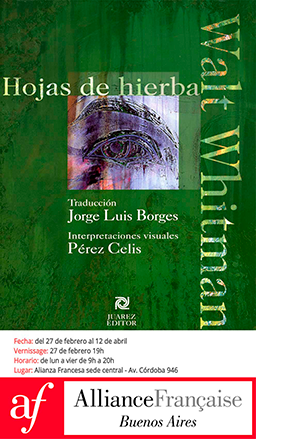HARMONY AND CHANCE IN HÉCTOR ZAMORA'S EMERGENCIA
Héctor Zamora (Mexico City, Mexico, 1974) navigates between opposing concepts. His particular interest in the incessant search, or in the eagerness of understanding, for conceptual equilibrium serves as an engine for a creative explosion in the search for that fragile space that results between actions and intentions, between should and being. In Emergencia, his first solo exhibition at Madrid's Albarrán Bourdais, the Mexican artist manages to capture in several dimensions that almost obsessive vocation of his personal struggle between the opposite poles that have been shaping his proposal.
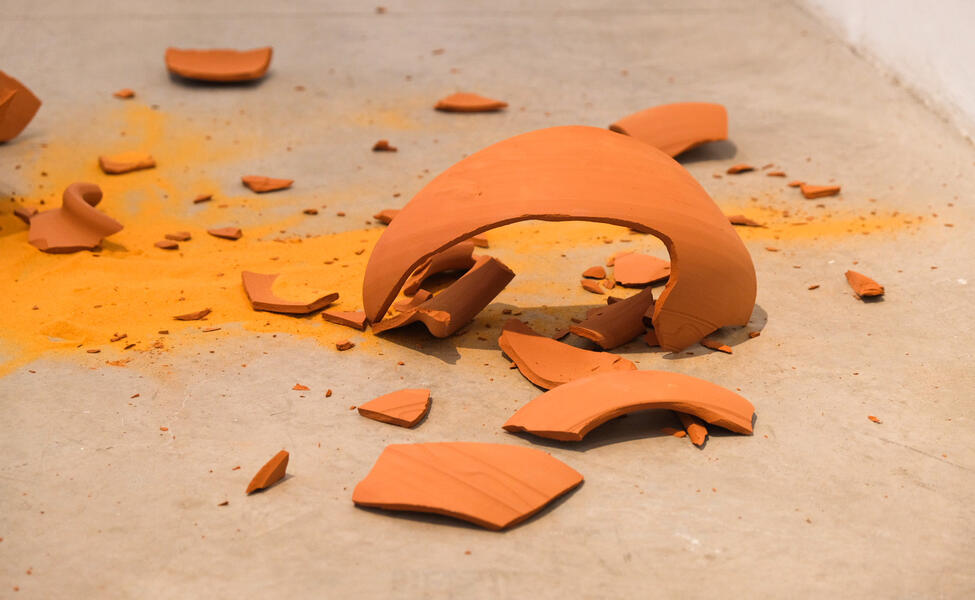
The central piece phagocytizes by its strength and disposition and breaks the scheme of unity. Or apparently. Some ceramic vessels are piled up in the lower part of the gallery. Some still retain their integrity, but others are affected by the passage of chance, of the out of control. Whoever finds himself in front of them without knowing the previous process, where some thirty actors executed a piece in which the pottery passed from hand to hand, accelerated, running a chain of fortune and challenging the inevitable breakage, could err on the side of some other reading of the language of Zamora, and surely valid.
We find ourselves facing the next evolution in the work of an artist who also greatly values the symbolism of brick and fired clay as material and artistic elements. In the last twenty years, Zamora has already used on occasion the circulation and manipulation of these objects by chains of people, delving, as on this occasion, into the concepts of construction, imagination and interconnected —and even collaborative— society.
Let's start from the premise that live art lacks the formalism that is presupposed in the spatial aspect of less ritualistic art and that, hence, the need for documentation arose. Without entering into the debate on whether the archive and its forms are artistic expressions in themselves, the artist leaves a testimony beyond the actual recording and subsequent exhibition of the performance. The result of the action remains and does so in a physical way, it does not evaporate, and marks the average within that balance between harmony and chaos, construction and destruction, indicating which part of that struggle of concepts stands as the winner or, if we do not want to apply a sportlike language, which of those will transcend.
The exhibition is complemented by some other pieces that maintain fired clay as a formal nexus, although the static dynamics of the piece that lies on the lower floor may end up as the only one in the memory. There is no illusory deception, for L'oeuf de vie delves from the geometric into the sacred and the totemic, into that almost innate reverence of any work exhibited in a museum environment and that proposes new visions on the functionality of space and the reinterpretation of the scale of values. Poralia accesses the confrontation with the rational and geometric, mathematical and tangible of materials and their qualities, which he challenges with hyperbolic paraboloids that, paradoxically, seem to have found their organic essence.
-
Emergencia. Héctor Zamora, 2024. Cortesía de Albarrán Bourdais
-
Emergencia. Héctor Zamora, 2024. Cortesía de Albarrán Bourdais
-
Héctor Zamora _ Poralia Emergencia. Héctor Zamora, 2024. Cortesía de Albarrán Bourdais
-
Héctor Zamora_Emergencia I. Emergencia. Héctor Zamora, 2024. Cortesía de Albarrán Bourdais
-
Héctor Zamora_Emergencia II. Emergencia. Héctor Zamora, 2024. Cortesía de Albarrán Bourdais
-
Héctor Zamora_Emergencia III. Emergencia. Héctor Zamora, 2024. Cortesía de Albarrán Bourdais
-
Héctor Zamora_Emergencia IV Emergencia. Héctor Zamora, 2024. Cortesía de Albarrán Bourdais
-
Héctor Zamora_Emergencia V. Emergencia. Héctor Zamora, 2024. Cortesía de Albarrán Bourdais
Emergencia. Héctor Zamora can be seen until October 26th at Albarrán Bourdais, Barquillo, 13, Madrid (Spain).
May interest you
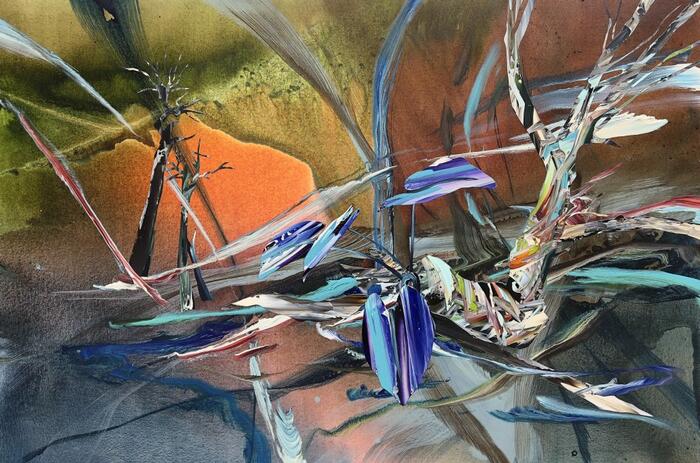
Germán Tagle (Santiago, Chile, 1976) returns to Madrid's Daniel Cuevas, where he held his first exhibition two years ago, with El territorio portátil, a show in which the Chilean artist returns to the axes of landscape, painting and culture that have been the backbone of his latest productions.
GERMÁN TAGLE'S REDEFINITION OF LANDSCAPE
Germán Tagle (Santiago, Chile, 1976) returns to Madrid's Daniel Cuevas, where he held his first exhibition two years ago, with El territorio portátil, a show in which the Chilean artist returns to the axes of landscape, painting and culture that have been the backbone of his latest productions.

Germán Tagle (Santiago, Chile, 1976) returns to Madrid's Daniel Cuevas, where he held his first exhibition two years ago, with El territorio portátil, a show in which the Chilean artist returns to the axes of landscape, painting and culture that have been the backbone of his latest productions.
GERMÁN TAGLE'S REDEFINITION OF LANDSCAPE
Germán Tagle (Santiago, Chile, 1976) returns to Madrid's Daniel Cuevas, where he held his first exhibition two years ago, with El territorio portátil, a show in which the Chilean artist returns to the axes of landscape, painting and culture that have been the backbone of his latest productions.
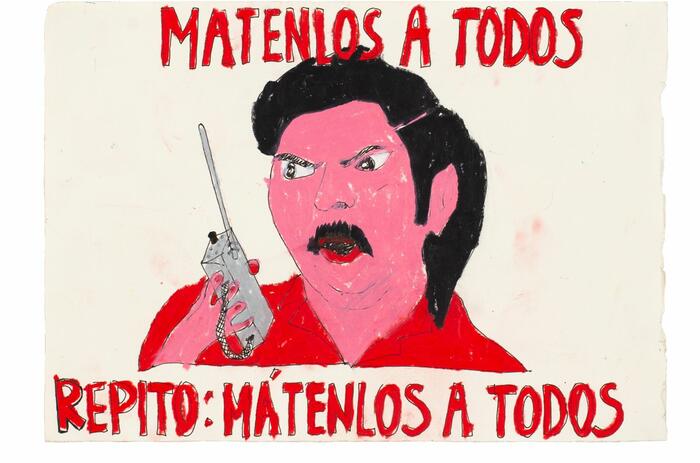
The double problem that arose from the acquisition in the 1980s of several hippopotamuses in one of the many eccentricities of the trafficker Pablo Escóbar is the starting point of a fable that, between the tragic and the comic, Camilo Restrepo (Medellín, Colombia, 1975) has managed to weave with a very successful graphic and conceptual narrative. With Cocaine Hippos Sweat Blood, the spectator faces this surrealistic story from its beginnings to the present by the hand of a figurativism that sets aside the academic and the technical for the sake of a greater aesthetic and relational concordance with that of the madness transmitted by the story itself.
THE NARCO-HYPOPOTAMUSES’ TALE, BY CAMILO RESTREPO
The double problem that arose from the acquisition in the 1980s of several hippopotamuses in one of the many eccentricities of the trafficker Pablo Escóbar is the starting point of a fable that, between the tragic and the comic, Camilo Restrepo (Medellín, Colombia, 1975) has managed to weave with a very successful graphic and conceptual narrative. With Cocaine Hippos Sweat Blood, the spectator faces this surrealistic story from its beginnings to the present by the hand of a figurativism that sets aside the academic and the technical for the sake of a greater aesthetic and relational concordance with that of the madness transmitted by the story itself.
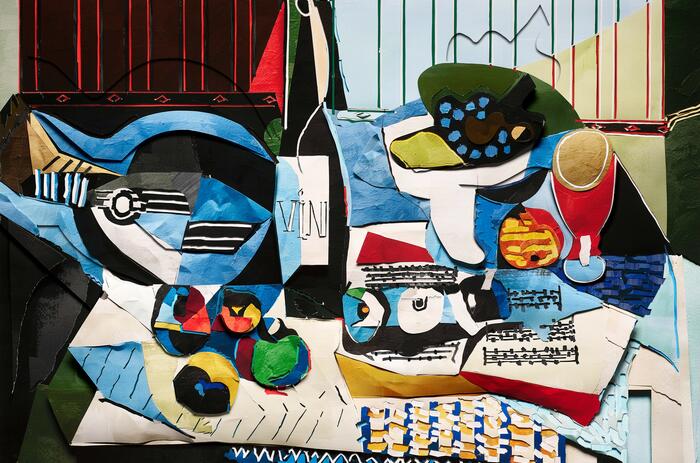
Madrid's Elba Benitez gallery has entrusted Vik Muniz (Sao Paulo, Brazil, 1961) with its first exhibition of the new season. Entitled Photocubism, the proposal is based on art historiography itself, recovering the cubist aesthetics as a substratum of the technical intervention he makes on iconic works of this movement. The Brazilian artist thus opts for this language to obtain new images that raise questions about perception and result.
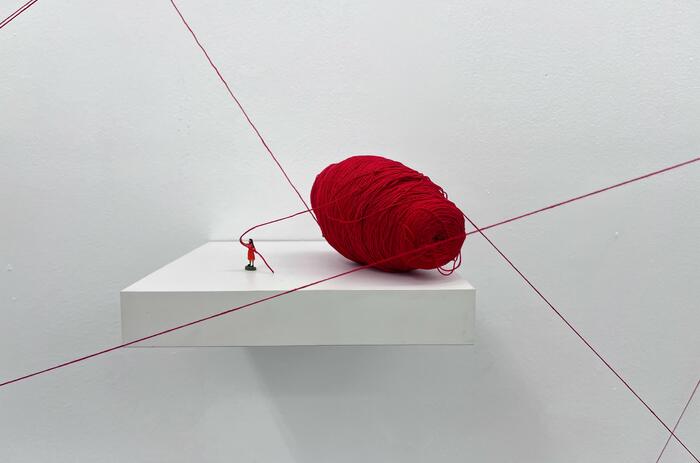
Liliana Porter (Buenos Aires, Argentina, 1941) has a long history shared with Espacio Minimo. The Madrid gallery pampers every move and celebrates the extensive relationship with the Argentinean artist, always offering her the possibility of receiving her work and witnessing its evolution. For the opening of the space's season, the landing is called Otros cuentos inconclusos, a new proposal that deals with representation and two dimensional axes —space and time— that bear witness to many of the questions raised about human relations.
THE UNFINISHED STORIES OF LILIANA PORTER
Liliana Porter (Buenos Aires, Argentina, 1941) has a long history shared with Espacio Minimo. The Madrid gallery pampers every move and celebrates the extensive relationship with the Argentinean artist, always offering her the possibility of receiving her work and witnessing its evolution. For the opening of the space's season, the landing is called Otros cuentos inconclusos, a new proposal that deals with representation and two dimensional axes —space and time— that bear witness to many of the questions raised about human relations.
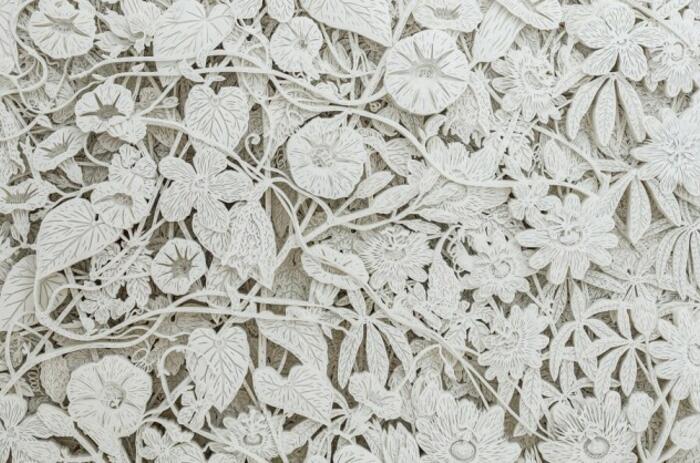
Cuban-born artist Ariamna Contino presents the exhibition Manigua at El Apartamento, in Spain to revisit the concept of “manigua”, a term historically used to refer to a tropical forest ecosystem.
ARIAMNA CONTINO: THE FOREST IS DISORDER, ABUNDANCE AND CONFUSION

Germán Tagle (Santiago, Chile, 1976) returns to Madrid's Daniel Cuevas, where he held his first exhibition two years ago, with El territorio portátil, a show in which the Chilean artist returns to the axes of landscape, painting and culture that have been the backbone of his latest productions.
GERMÁN TAGLE'S REDEFINITION OF LANDSCAPE
Germán Tagle (Santiago, Chile, 1976) returns to Madrid's Daniel Cuevas, where he held his first exhibition two years ago, with El territorio portátil, a show in which the Chilean artist returns to the axes of landscape, painting and culture that have been the backbone of his latest productions.

The double problem that arose from the acquisition in the 1980s of several hippopotamuses in one of the many eccentricities of the trafficker Pablo Escóbar is the starting point of a fable that, between the tragic and the comic, Camilo Restrepo (Medellín, Colombia, 1975) has managed to weave with a very successful graphic and conceptual narrative. With Cocaine Hippos Sweat Blood, the spectator faces this surrealistic story from its beginnings to the present by the hand of a figurativism that sets aside the academic and the technical for the sake of a greater aesthetic and relational concordance with that of the madness transmitted by the story itself.
THE NARCO-HYPOPOTAMUSES’ TALE, BY CAMILO RESTREPO
The double problem that arose from the acquisition in the 1980s of several hippopotamuses in one of the many eccentricities of the trafficker Pablo Escóbar is the starting point of a fable that, between the tragic and the comic, Camilo Restrepo (Medellín, Colombia, 1975) has managed to weave with a very successful graphic and conceptual narrative. With Cocaine Hippos Sweat Blood, the spectator faces this surrealistic story from its beginnings to the present by the hand of a figurativism that sets aside the academic and the technical for the sake of a greater aesthetic and relational concordance with that of the madness transmitted by the story itself.

Madrid's Elba Benitez gallery has entrusted Vik Muniz (Sao Paulo, Brazil, 1961) with its first exhibition of the new season. Entitled Photocubism, the proposal is based on art historiography itself, recovering the cubist aesthetics as a substratum of the technical intervention he makes on iconic works of this movement. The Brazilian artist thus opts for this language to obtain new images that raise questions about perception and result.

Liliana Porter (Buenos Aires, Argentina, 1941) has a long history shared with Espacio Minimo. The Madrid gallery pampers every move and celebrates the extensive relationship with the Argentinean artist, always offering her the possibility of receiving her work and witnessing its evolution. For the opening of the space's season, the landing is called Otros cuentos inconclusos, a new proposal that deals with representation and two dimensional axes —space and time— that bear witness to many of the questions raised about human relations.
THE UNFINISHED STORIES OF LILIANA PORTER
Liliana Porter (Buenos Aires, Argentina, 1941) has a long history shared with Espacio Minimo. The Madrid gallery pampers every move and celebrates the extensive relationship with the Argentinean artist, always offering her the possibility of receiving her work and witnessing its evolution. For the opening of the space's season, the landing is called Otros cuentos inconclusos, a new proposal that deals with representation and two dimensional axes —space and time— that bear witness to many of the questions raised about human relations.

Cuban-born artist Ariamna Contino presents the exhibition Manigua at El Apartamento, in Spain to revisit the concept of “manigua”, a term historically used to refer to a tropical forest ecosystem.
ARIAMNA CONTINO: THE FOREST IS DISORDER, ABUNDANCE AND CONFUSION

Germán Tagle (Santiago, Chile, 1976) returns to Madrid's Daniel Cuevas, where he held his first exhibition two years ago, with El territorio portátil, a show in which the Chilean artist returns to the axes of landscape, painting and culture that have been the backbone of his latest productions.
GERMÁN TAGLE'S REDEFINITION OF LANDSCAPE
Germán Tagle (Santiago, Chile, 1976) returns to Madrid's Daniel Cuevas, where he held his first exhibition two years ago, with El territorio portátil, a show in which the Chilean artist returns to the axes of landscape, painting and culture that have been the backbone of his latest productions.

The double problem that arose from the acquisition in the 1980s of several hippopotamuses in one of the many eccentricities of the trafficker Pablo Escóbar is the starting point of a fable that, between the tragic and the comic, Camilo Restrepo (Medellín, Colombia, 1975) has managed to weave with a very successful graphic and conceptual narrative. With Cocaine Hippos Sweat Blood, the spectator faces this surrealistic story from its beginnings to the present by the hand of a figurativism that sets aside the academic and the technical for the sake of a greater aesthetic and relational concordance with that of the madness transmitted by the story itself.
THE NARCO-HYPOPOTAMUSES’ TALE, BY CAMILO RESTREPO
The double problem that arose from the acquisition in the 1980s of several hippopotamuses in one of the many eccentricities of the trafficker Pablo Escóbar is the starting point of a fable that, between the tragic and the comic, Camilo Restrepo (Medellín, Colombia, 1975) has managed to weave with a very successful graphic and conceptual narrative. With Cocaine Hippos Sweat Blood, the spectator faces this surrealistic story from its beginnings to the present by the hand of a figurativism that sets aside the academic and the technical for the sake of a greater aesthetic and relational concordance with that of the madness transmitted by the story itself.

Madrid's Elba Benitez gallery has entrusted Vik Muniz (Sao Paulo, Brazil, 1961) with its first exhibition of the new season. Entitled Photocubism, the proposal is based on art historiography itself, recovering the cubist aesthetics as a substratum of the technical intervention he makes on iconic works of this movement. The Brazilian artist thus opts for this language to obtain new images that raise questions about perception and result.

Liliana Porter (Buenos Aires, Argentina, 1941) has a long history shared with Espacio Minimo. The Madrid gallery pampers every move and celebrates the extensive relationship with the Argentinean artist, always offering her the possibility of receiving her work and witnessing its evolution. For the opening of the space's season, the landing is called Otros cuentos inconclusos, a new proposal that deals with representation and two dimensional axes —space and time— that bear witness to many of the questions raised about human relations.
THE UNFINISHED STORIES OF LILIANA PORTER
Liliana Porter (Buenos Aires, Argentina, 1941) has a long history shared with Espacio Minimo. The Madrid gallery pampers every move and celebrates the extensive relationship with the Argentinean artist, always offering her the possibility of receiving her work and witnessing its evolution. For the opening of the space's season, the landing is called Otros cuentos inconclusos, a new proposal that deals with representation and two dimensional axes —space and time— that bear witness to many of the questions raised about human relations.

Cuban-born artist Ariamna Contino presents the exhibition Manigua at El Apartamento, in Spain to revisit the concept of “manigua”, a term historically used to refer to a tropical forest ecosystem.
ARIAMNA CONTINO: THE FOREST IS DISORDER, ABUNDANCE AND CONFUSION

Germán Tagle (Santiago, Chile, 1976) returns to Madrid's Daniel Cuevas, where he held his first exhibition two years ago, with El territorio portátil, a show in which the Chilean artist returns to the axes of landscape, painting and culture that have been the backbone of his latest productions.
GERMÁN TAGLE'S REDEFINITION OF LANDSCAPE
Germán Tagle (Santiago, Chile, 1976) returns to Madrid's Daniel Cuevas, where he held his first exhibition two years ago, with El territorio portátil, a show in which the Chilean artist returns to the axes of landscape, painting and culture that have been the backbone of his latest productions.

The double problem that arose from the acquisition in the 1980s of several hippopotamuses in one of the many eccentricities of the trafficker Pablo Escóbar is the starting point of a fable that, between the tragic and the comic, Camilo Restrepo (Medellín, Colombia, 1975) has managed to weave with a very successful graphic and conceptual narrative. With Cocaine Hippos Sweat Blood, the spectator faces this surrealistic story from its beginnings to the present by the hand of a figurativism that sets aside the academic and the technical for the sake of a greater aesthetic and relational concordance with that of the madness transmitted by the story itself.
THE NARCO-HYPOPOTAMUSES’ TALE, BY CAMILO RESTREPO
The double problem that arose from the acquisition in the 1980s of several hippopotamuses in one of the many eccentricities of the trafficker Pablo Escóbar is the starting point of a fable that, between the tragic and the comic, Camilo Restrepo (Medellín, Colombia, 1975) has managed to weave with a very successful graphic and conceptual narrative. With Cocaine Hippos Sweat Blood, the spectator faces this surrealistic story from its beginnings to the present by the hand of a figurativism that sets aside the academic and the technical for the sake of a greater aesthetic and relational concordance with that of the madness transmitted by the story itself.

Madrid's Elba Benitez gallery has entrusted Vik Muniz (Sao Paulo, Brazil, 1961) with its first exhibition of the new season. Entitled Photocubism, the proposal is based on art historiography itself, recovering the cubist aesthetics as a substratum of the technical intervention he makes on iconic works of this movement. The Brazilian artist thus opts for this language to obtain new images that raise questions about perception and result.

Liliana Porter (Buenos Aires, Argentina, 1941) has a long history shared with Espacio Minimo. The Madrid gallery pampers every move and celebrates the extensive relationship with the Argentinean artist, always offering her the possibility of receiving her work and witnessing its evolution. For the opening of the space's season, the landing is called Otros cuentos inconclusos, a new proposal that deals with representation and two dimensional axes —space and time— that bear witness to many of the questions raised about human relations.
THE UNFINISHED STORIES OF LILIANA PORTER
Liliana Porter (Buenos Aires, Argentina, 1941) has a long history shared with Espacio Minimo. The Madrid gallery pampers every move and celebrates the extensive relationship with the Argentinean artist, always offering her the possibility of receiving her work and witnessing its evolution. For the opening of the space's season, the landing is called Otros cuentos inconclusos, a new proposal that deals with representation and two dimensional axes —space and time— that bear witness to many of the questions raised about human relations.

Cuban-born artist Ariamna Contino presents the exhibition Manigua at El Apartamento, in Spain to revisit the concept of “manigua”, a term historically used to refer to a tropical forest ecosystem.
ARIAMNA CONTINO: THE FOREST IS DISORDER, ABUNDANCE AND CONFUSION

Germán Tagle (Santiago, Chile, 1976) returns to Madrid's Daniel Cuevas, where he held his first exhibition two years ago, with El territorio portátil, a show in which the Chilean artist returns to the axes of landscape, painting and culture that have been the backbone of his latest productions.
GERMÁN TAGLE'S REDEFINITION OF LANDSCAPE
Germán Tagle (Santiago, Chile, 1976) returns to Madrid's Daniel Cuevas, where he held his first exhibition two years ago, with El territorio portátil, a show in which the Chilean artist returns to the axes of landscape, painting and culture that have been the backbone of his latest productions.

The double problem that arose from the acquisition in the 1980s of several hippopotamuses in one of the many eccentricities of the trafficker Pablo Escóbar is the starting point of a fable that, between the tragic and the comic, Camilo Restrepo (Medellín, Colombia, 1975) has managed to weave with a very successful graphic and conceptual narrative. With Cocaine Hippos Sweat Blood, the spectator faces this surrealistic story from its beginnings to the present by the hand of a figurativism that sets aside the academic and the technical for the sake of a greater aesthetic and relational concordance with that of the madness transmitted by the story itself.
THE NARCO-HYPOPOTAMUSES’ TALE, BY CAMILO RESTREPO
The double problem that arose from the acquisition in the 1980s of several hippopotamuses in one of the many eccentricities of the trafficker Pablo Escóbar is the starting point of a fable that, between the tragic and the comic, Camilo Restrepo (Medellín, Colombia, 1975) has managed to weave with a very successful graphic and conceptual narrative. With Cocaine Hippos Sweat Blood, the spectator faces this surrealistic story from its beginnings to the present by the hand of a figurativism that sets aside the academic and the technical for the sake of a greater aesthetic and relational concordance with that of the madness transmitted by the story itself.

Madrid's Elba Benitez gallery has entrusted Vik Muniz (Sao Paulo, Brazil, 1961) with its first exhibition of the new season. Entitled Photocubism, the proposal is based on art historiography itself, recovering the cubist aesthetics as a substratum of the technical intervention he makes on iconic works of this movement. The Brazilian artist thus opts for this language to obtain new images that raise questions about perception and result.

Liliana Porter (Buenos Aires, Argentina, 1941) has a long history shared with Espacio Minimo. The Madrid gallery pampers every move and celebrates the extensive relationship with the Argentinean artist, always offering her the possibility of receiving her work and witnessing its evolution. For the opening of the space's season, the landing is called Otros cuentos inconclusos, a new proposal that deals with representation and two dimensional axes —space and time— that bear witness to many of the questions raised about human relations.
THE UNFINISHED STORIES OF LILIANA PORTER
Liliana Porter (Buenos Aires, Argentina, 1941) has a long history shared with Espacio Minimo. The Madrid gallery pampers every move and celebrates the extensive relationship with the Argentinean artist, always offering her the possibility of receiving her work and witnessing its evolution. For the opening of the space's season, the landing is called Otros cuentos inconclusos, a new proposal that deals with representation and two dimensional axes —space and time— that bear witness to many of the questions raised about human relations.

Cuban-born artist Ariamna Contino presents the exhibition Manigua at El Apartamento, in Spain to revisit the concept of “manigua”, a term historically used to refer to a tropical forest ecosystem.

